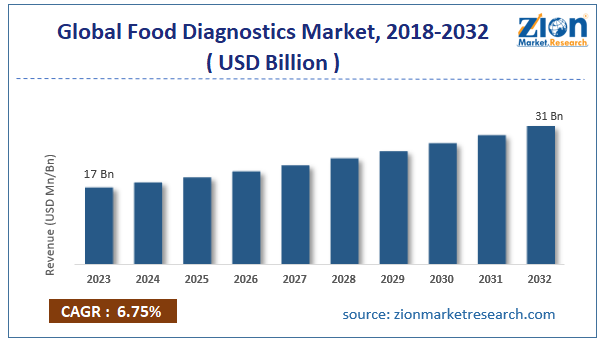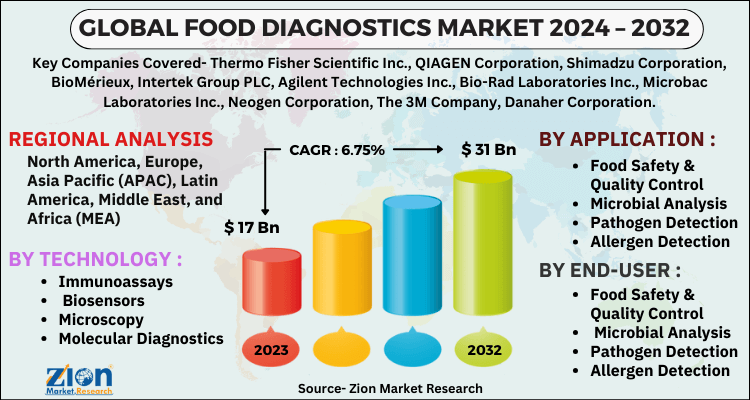Food Diagnostics Market Size, Share, Trends, Growth and Forecast 2032

Food Diagnostics Market By Technology (Immunoassays, Biosensors, Microscopy, and Molecular Diagnostics), By Application (Food Safety & Quality Control, Microbial Analysis, Pathogen Detection, and Allergen Detection), By End-User (Food Manufacturing Firms, Food Testing Laboratories, and Government Agencies), and By Region - Global and Regional Industry Overview, Market Intelligence, Comprehensive Analysis, Historical Data, and Forecasts 2024 - 2032
| Market Size in 2023 | Market Forecast in 2032 | CAGR (in %) | Base Year |
|---|---|---|---|
| USD 17 Billion | USD 31 Billion | 6.75% | 2023 |
Food Diagnostics Industry Prospective:
The global food diagnostics market size was evaluated at $17 billion in 2023 and is slated to hit $31 billion by the end of 2032 with a CAGR of nearly 6.75% between 2024 and 2032.
Food Diagnostics Market: Overview
Food diagnostics is a key field utilizing new tools for ensuring high quality and security of food items. Moreover, it involves a spectrum of techniques that are used for detecting allergens, contaminants, and pathogens. Additionally, food diagnostics safeguards consumer from foodborne diseases & allergens. Reportedly, major techniques used in food diagnostics include microbiological testing, allergen testing, chemical analysis, and molecular biology.
Key Insights
- As per the analysis shared by our research analyst, the global food diagnostics market is projected to expand annually at the annual growth rate of around 6.75% over the forecast timespan (2024-2032)
- In terms of revenue, the global food diagnostics market size was evaluated at nearly $17 billion in 2023 and is expected to reach $31 billion by 2032.
- The global food diagnostics market is anticipated to grow rapidly over the forecast timeline owing to surging customer awareness about food safety along with strict government norms.
- In terms of technology, the molecular diagnostics segment is slated to register the highest CAGR over the forecast period.
- Based on application, the food safety & quality control segment is predicted to contribute majorly towards global market revenue in the ensuing years.
- On the basis of end-user, the food manufacturing firms segment is likely to maintain segmental domination in the forthcoming years.
- Region-wise, the North American food diagnostics industry is projected to register the fastest CAGR during the assessment timespan.
Food Diagnostics Market: Growth Factors
Escalating end-user demand for food safety to prop up the global market trends over forecast period
Surging customer awareness about food safety along with strict government norms will proliferate the growth of the food diagnostics market worldwide. Furthermore, launching of rapid diagnostic tests, automation & digitization, and use of advanced analytics methods will embellish the scope of global market expansion.
Moreover, the middle-income group population in developing countries prefers high-quality food items and this can translate into humungous market growth in the coming years. Escalating food safety issues and strict laws regulating food processing activities and bringing improvement in quality of food for addressing health concerns of the people will drive the global market trends. An increment in the cases of food allergies & intolerances will create massive demand for food diagnostics in the ensuing years.
Food Diagnostics Market: Restraints
Escalating costs of food diagnostics equipment can retard the growth of the global industry
Surging prices of food testing & advanced diagnostics methods and equipment can prove to be detrimental for the growth of the global food diagnostics industry. Furthermore, lack of uniform standard testing protocols along with inconsistencies in the outcomes can slow down the expansion of the industry globally.
Food Diagnostics Market: Opportunities
A surge in the fund allocation for purpose of improving food quality & disease prevention to foster the global market surge
An increase in the investments for ensuring food safety and technological breakthroughs in diagnostics such as rapid testing & smartphone-based diagnostics is anticipated to boost the global food diagnostics market progression. In addition to this, breakthroughs in the molecular diagnostics are expected to proliferate the global market size in the years ahead. Integrating of digital systems and use of block chain technology will propel the market elevation in the ensuing years.
Food Diagnostics Market: Challenges
Escalating prices of raw components can deteriorate the global industry expansion by 2032
Complications witnessed in food testing procedures and surging prices of compliance laws can challenge the global food diagnostics industry surge. Furthermore, high raw material costs along with irregular supply of these raw products can obstruct the global industry expansion in the years ahead.
Food Diagnostics Market: Report Scope
| Report Attributes | Report Details |
|---|---|
| Report Name | Food Diagnostics Market |
| Market Size in 2023 | USD 17 Billion |
| Market Forecast in 2032 | USD 31 Billion |
| Growth Rate | CAGR of 6.75% |
| Number of Pages | 216 |
| Key Companies Covered | Thermo Fisher Scientific Inc., QIAGEN Corporation, Shimadzu Corporation, BioMérieux, Intertek Group PLC, Agilent Technologies Inc., Bio-Rad Laboratories Inc., Microbac Laboratories Inc., Neogen Corporation, The 3M Company, Danaher Corporation, Merck KGaA, Bruker Corporation, Eurofins Scientific SE., and others. |
| Segments Covered | By Technology, By Application, By End-User , and By Region |
| Regions Covered | North America, Europe, Asia Pacific (APAC), Latin America, Middle East, and Africa (MEA) |
| Base Year | 2023 |
| Historical Year | 2018 to 2022 |
| Forecast Year | 2024 - 2032 |
| Customization Scope | Avail customized purchase options to meet your exact research needs. Request For Customization |
Food Diagnostics Market: Segmentation
The global food diagnostics market is divided into technology, application, end-user, and region.
In terms of technology, the food diagnostics market across the globe is segmented into immunoassays, biosensors, microscopy, and molecular diagnostics segments. Apparently, the molecular diagnostics segment, which garnered nearly 53% of the global market earnings in 2023, is set to record fastest CAGR in the next couple of years subject to growing sensitivity and specificity provided by DNA sequencing & PCR in identifying pollutants, pathogens, and allergens.
Based on the application, the global food diagnostics industry is divided into food safety & quality control, microbial analysis, pathogen detection, and allergen detection segments. Apparently, the food safety & quality control segment, which led the global industry share in 2023, is likely to contribute lucratively towards the global market size in the coming years and this can be subject to surging customer awareness about food safety & quality and strict laws enforced by government related to food quality & safety leading to need for food diagnostics. Moreover, rising cases of foodborne ailments have led the government opts for food testing, thereby enhancing the use of food diagnostics in food safety & quality control segment.
On the basis of end-user, the global food diagnostics market is segregated into food manufacturing firms, food testing laboratories, and government agencies segments. Moreover, the food manufacturing firms segment, which led the segmental surge in 2023, is likely to maintain its segmental dominance even in the upcoming years subject to growing focus of food producers on quality assurance, brand reputation, and strict enforcement of food safety laws globally.
Food Diagnostics Market: Regional Insights
Asia-Pacific is projected to maintain leading status in the global market over the projected timespan
Asia-Pacific, which accounted for about 55% of the global food diagnostics market size in 2023, is expected to establish a leading position in the global market during the forecast timespan. In addition to this, the regional market progress in the coming seven years can be due to swift economic development, rising food safety issues, and an increase in the middle-income population preferring packaged & processed foods.
North American food diagnostics industry is anticipated to register the highest CAGR in the expected timeline. The geometric expansion of the industry in North American can be credited to presence of key players in the countries such as the U.S. Apart from this, surging cases of food-related ailments and customer awareness about food safety in the region is likely to contribute lucratively towards the regional market surge in the ensuing years.
Food Diagnostics Market: Competitive Space
The global food diagnostics market profiles key players such as:
- Thermo Fisher Scientific Inc.
- QIAGEN Corporation
- Shimadzu Corporation
- BioMérieux
- Intertek Group PLC
- Agilent Technologies Inc.
- Bio-Rad Laboratories Inc.
- Microbac Laboratories Inc.
- Neogen Corporation
- The 3M Company
- Danaher Corporation
- Merck KGaA
- Bruker Corporation
- Eurofins Scientific SE.
The global food diagnostics market is segmented as follows:
By Technology
- Immunoassays
- Biosensors
- Microscopy
- Molecular Diagnostics
By Application
- Food Safety & Quality Control
- Microbial Analysis
- Pathogen Detection
- Allergen Detection
By End-User
- Food Safety & Quality Control
- Microbial Analysis
- Pathogen Detection
- Allergen Detection
By Region
- North America
- The U.S.
- Canada
- Europe
- France
- The UK
- Spain
- Germany
- Italy
- Rest of Europe
- Asia Pacific
- China
- Japan
- India
- South Korea
- Southeast Asia
- Rest of Asia Pacific
- Latin America
- Brazil
- Mexico
- Rest of Latin America
- Middle East & Africa
- GCC
- South Africa
- Rest of Middle East & Africa
Table Of Content
Methodology
FrequentlyAsked Questions
Food diagnostics is a key field utilizing new tools for ensuring high quality and security of food items.
The global food diagnostics market growth over the forecast period can be owing to launching of rapid diagnostic tests, automation & digitization, and use of advanced analytics methods.
According to a study, the global food diagnostics industry size was $17 billion in 2023 and is projected to reach $31 billion by the end of 2032.
The global food diagnostics market is anticipated to record a CAGR of nearly 6.75% from 2024 to 2032.
North American food diagnostics industry is set to register the fastest CAGR over the forecasting timeframe owing to presence of key players in the countries such as the U.S. Apart from this, surging cases of food-related ailments and customer awareness about food safety in the region is likely to contribute lucratively towards the regional market surge in the ensuing years.
The global food diagnostics market is led by players such as Thermo Fisher Scientific Inc., QIAGEN Corporation, Shimadzu Corporation, BioMérieux, Intertek Group PLC, Agilent Technologies Inc., Bio-Rad Laboratories, Inc., Microbac Laboratories Inc., Neogen Corporation, The 3M Company, Danaher Corporation, Merck KGaA, Bruker Corporation, and Eurofins Scientific SE.
The global food diagnostics market report covers the geographical market along with a comprehensive competitive landscape analysis. It also includes cash flow analysis, profit ratio analysis, market basket analysis, cash-benefit analysis, market attractiveness analysis, sentiment analysis, PESTEL analysis, trend analysis, SWOT analysis, trade area analysis, demand & supply analysis, Porter’s five force analysis, factor analysis, and value chain analysis. It provides an apt scenario about demand and factor conditions in the country impacting the profitability of the firms in the domestic and international markets.
HappyClients
Zion Market Research
Tel: +1 (302) 444-0166
USA/Canada Toll Free No.+1 (855) 465-4651
3rd Floor,
Mrunal Paradise, Opp Maharaja Hotel,
Pimple Gurav, Pune 411061,
Maharashtra, India
Phone No +91 7768 006 007, +91 7768 006 008
US OFFICE NO +1 (302) 444-0166
US/CAN TOLL FREE +1 (855) 465-4651
Email: sales@zionmarketresearch.com
We have secured system to process your transaction.
Our support available to help you 24 hours a day, five days a week.
Monday - Friday: 9AM - 6PM
Saturday - Sunday: Closed







